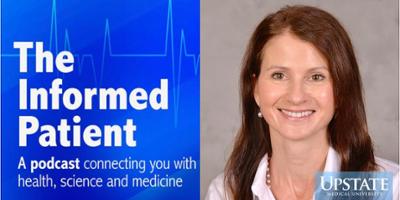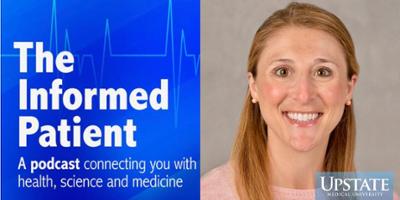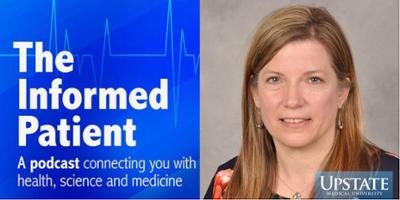
A dietitian tells how to make easy, crustless mini-quiches
Transcript
Host Amber Smith: Upstate Medical University in Syracuse, New York invites you to be "The Informed Patient" with the podcast that features experts from Central New York's only academic medical center. I'm your host, Amber Smith.
Nutrition is important all the time, but it can be especially challenging for someone who is in cancer treatment. Today, I'm talking with Katie Krawczyk. She's the Upstate Cancer Center's registered dietician nutritionist, and she agreed to share a quiche recipe that's easy to prepare and versatile. Welcome to "The Informed Patient," Ms. Krawczyk.
Katie Krawczyk: Thanks for having me Amber.
Host Amber Smith: Now, please tell me why you like to share this particular recipe with patients.
Katie Krawczyk: I love to share this recipe for little mini quiche or an egg muffin, whatever you wanna call it, because it's so versatile. And, it gives patients a little bit more of an appetite when I say, "OK, let's incorporate some protein foods into your diet," and we talk about eggs, and oftentimes patients will say, "well, I'm sick of scrambled eggs in the morning." So this recipe is very easy and allows a patient to really adjust it to the flavors that they like.
Host Amber Smith: Well, without the traditional pie crust of a quiche, does that help reduce the calories?
Katie Krawczyk: Without that base, there will be a little bit less calories, but I think that it makes this recipe very easy to prepare without that kind of pie crust.
Host Amber Smith: Now, obviously this recipe has eggs, so I wanted to ask you about the nutritional value of the egg, because I've always heard it's a "complete" source of protein, but what does that mean, complete?
Katie Krawczyk: Complete protein is when it contains the nine essential amino acids that our body cannot produce on its own. So amino acids are the smaller component to a protein. Most sources of complete protein come from animal products.
Host Amber Smith: Is protein extra important during cancer treatment?
Katie Krawczyk: Protein is very crucial during cancer treatment. You wanna make sure that, really, every time you eat, you should have a source of protein, in addition to good variety in your diet and enough calories in general.
Host Amber Smith: Well, let me ask you to sort of help us compile a shopping list. I know a dozen eggs is at the top of that list. Would an egg substitute work?
Katie Krawczyk: A substitute would work perfect in this recipe as well. So you can use either your regular eggs that we're going to crack, or you can use the liquid eggs.
Host Amber Smith: And then what else do we need?
Katie Krawczyk: With this recipe, we'll also have 1/2 a cup of heavy cream, a 1/4 cup of milk.
Host Amber Smith: Let me ask you on the milk, if you don't mind, does it need to be cow's milk or can you use a milk substitute?
Katie Krawczyk: Use any milk substitute that you're used to having in your home, whether that be almond milk or soy milk or any other lactose-free milk, as long as it's unflavored.
Host Amber Smith: Now, if someone has lactose intolerance making this recipe, can they omit the heavy cream?
Katie Krawczyk: Yes, you can take that heavy cream out and then just increase that 1/4 cup milk to a 1/2 a cup of milk, or that lactose free milk that, that you might be using.
We'll also add some fresh parsley and basil, 2 tablespoons each, but you can also use dried spices here, whether that be oregano or an Italian blend, or garlic powder also works well. And when using the dried spice, we can reduce that amount from the 2 tablespoons with the fresh ingredients, fresh herbs, to about one teaspoon.
You can also add 1/4 teaspoon of salt and pepper, and 1 cup of cheese.
Host Amber Smith: Now on the cheese, what flavor cheese do you recommend?
Katie Krawczyk: Again, this recipe is very versatile. So whatever cheese that you like, whether that be cheddar or mozzarella or gouda -- those all work really well here.
Host Amber Smith: Now, does it matter if you're using no-fat cheese or low-fat cheese or an alternative to cheese made with cow's milk?
Katie Krawczyk: That depends on, kind of, patient to patient. If you are a patient who is struggling to maintain weight, go with that full fat. If you are a patient who would like to watch the waistline, then choose the lower fat. So either way, this will cook up really nicely.
Host Amber Smith: Now, what about the vegetables?
Katie Krawczyk: For vegetables, again, this is really versatile. You can even do a variety within these kind of muffin tins that we're going to be creating. You can have different flavors within each one. So some good choices include broccoli, spinach, red bell pepper, onion. And if you're looking for a little bit more flavor, you can even add a jalapeno pepper.
Host Amber Smith: So it sounds like you can look at what you have in your refrigerator and see if that would work. Or go to the store or the market and pick whatever catches your eye.
Katie Krawczyk: Absolutely. And these will be really colorful too, to catch your eye.
Host Amber Smith: Could someone add meat if they wanted to? I'm thinking chopped up bacon, or ham, or ground beef, for instance?
Katie Krawczyk: Absolutely. A good combination might be bacon, cheddar and mushroom, for example. Or yes, you can use sausage or ham. And then other ideas for vegetables: you could add zucchini right now is in season, tomato, potatoes, white or purple onion.
Host Amber Smith: Now this recipe has 12 eggs, and it's meant to fill a 12-section muffin tin. Could you double the recipe if you wanted to make, like, 24 of these mini quiches at once?
Katie Krawczyk: Absolutely. And I would recommend that because these quiches can be a grab-and-go snack or meal. So if you wanna make extra, they freeze really well. And then you can just take them out of the freezer to thaw and then microwave for about 30 seconds when you want to enjoy them.
Host Amber Smith: This is Upstate's "The Informed Patient" podcast. I'm your host, Amber Smith talking with Katie Krawczyk. She's the registered dietician nutritionist who works at the Upstate Cancer Center, and she's sharing with us a quiche recipe that she likes to share with her patients. Listeners can find this recipe connected to this interview on our website at Upstate.edu/Informed.
So, now let's talk about the preparation. What kind of pan do you recommend, and do you need to spray it ahead of time?
Katie Krawczyk: To bake this, we're going to use a muffin or cupcake pan, and you do want to spray it with a non-stick spray, or you can utilize butter or coconut oil for each individual, little muffin space.
You'll also need a bowl to whisk the eggs and add in all the vegetables and cheese. I like to use my large Pyrex measuring cup because it has a spout that's easy to pour the mixture into the muffin tins. You'll also need a knife and cutting board to chop your vegetables into, kind of dice them into a little bit smaller than your bite size to incorporate into the eggs nicely.
Host Amber Smith: I've heard some people like to saute their onions before they use them in a recipe like this. Do you recommend that?
Katie Krawczyk: You can saute all your vegetables, including onions. If you're utilizing them. You do not have to, but it will just kind of take away that little bite for onions and make the vegetables a little bit more tender. And then at that time, when you're sauteing, if you want to add your salt and pepper, or other dried spices, you can do so, but it is not required. You can just put the broccoli, the peppers and onions, incorporated into the eggs without sauteing.
Host Amber Smith: Let me ask you on all the broccoli, spinach, red pepper, whatever you're using. Do the chunks, when you cut them, are you looking for them to be about equal in size?
Katie Krawczyk: Yes. That will just better help incorporate so that you get that flavor of all of your ingredients within one bite.
Host Amber Smith: Also, should the oven be preheating while we're doing all of this? I forgot to ask at the beginning.
Katie Krawczyk: Yes. We're going to cook these at 375, so you can preheat your oven right away, because this is such a quick recipe. So we're just whisking the eggs with the vegetables in there and pouring them into the muffin tins, so we can preheat your oven right away, unless you're going to be sauteing. Even that wouldn't, won't take too long. So your first step can be to turn on the oven to get that heated up.
Host Amber Smith: Now, the cheese is the last thing that you would stir into this, is that right?
Yep. I should ask you, we're talking about shredded cheese, right?
Katie Krawczyk: Yes. You do want your cheese to be shredded, whether you're purchasing that pre-shredded, or shredding it yourself.
Host Amber Smith: All right. So once that is stirred in, I know you work with a batter bowl so that you can easily pour it. if someone doesn't have that, would like a ladle work?
Katie Krawczyk: Absolutely -- a ladle or an ice cream scooper.
Host Amber Smith: And how high up should you fill each of the sections?
Katie Krawczyk: Fill each muffin tin to about three quarters of the way up, or there's a quarter left to that top before overflowing.
Host Amber Smith: All right. And I think you said 375. How long do they cook, and how do you know when they're done?
Katie Krawczyk: They're going to bake for 20 to 25 minutes or until that egg is fully set, so it doesn't jiggle when you move it, and the cheese has just started to turn golden on top.
And then you need to let them cool a little before you can get them out of the pan?
Katie Krawczyk: Yep. Once they're done cooking, take them out of the oven, leave them put for about five to 10 minutes, and then they should come out of the tins really easily, if they use a butter knife around them to help just kind of pull them from the sides. And then you can eat them warm or let them cool completely and store them in a container in the refrigerator. Or, again, you can also freeze these.
Host Amber Smith: How long do they last in the refrigerator? If I made 'em on a Monday morning, can I eat them all week?
Katie Krawczyk: Yep. For one week.
Host Amber Smith: Many people think of eggs for breakfast. Do you think these mini quiches could make for satisfying lunches or dinners?
Katie Krawczyk: Absolutely. If you are thinking -- again, this is a prep-ahead meal -- if you say, oh, OK yeah, I've got these egg muffins in my freezer. Take them out and reheat them in the microwave and have them as your dinner, maybe alongside of some toast. Or have a full breakfast for dinner, like you have pancakes there.
Thank you for this mini quiche recipe, Ms. Krawczyk. Thank you for having me.
Host Amber Smith: My guest has been registered dietician nutritionist, Katie Krawczyk from the Upstate Cancer Center. "The Informed Patient" is a podcast covering health science and medicine brought to you by Upstate Medical University in Syracuse, New York, and produced by Jim Howe. Find our archive of previous episodes at Upstate.edu/informed. This is your host, Amber Smith, thanking you for listening.




